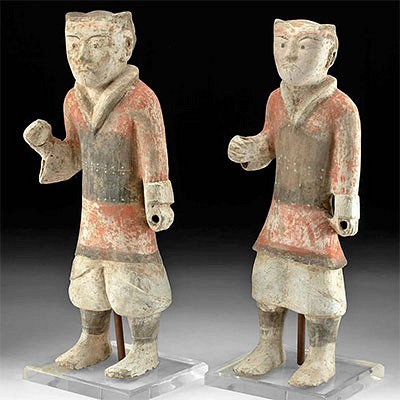19th C. Moroccan Pottery Mokhfia Bowl, ex Museum
Lot 155
About Seller
Artemis Gallery
686 S Taylor Ave, Ste 106
Louisville, CO 80027
United States
Selling antiquities, ancient and ethnographic art online since 1993, Artemis Gallery specializes in Classical Antiquities (Egyptian, Greek, Roman, Near Eastern), Asian, Pre-Columbian, African / Tribal / Oceanographic art. Our extensive inventory includes pottery, stone, metal, wood, glass and textil...Read more
Categories
Estimate:
$300 - $450
Absentee vs Live bid
Two ways to bid:
- Leave a max absentee bid and the platform will bid on your behalf up to your maximum bid during the live auction.
- Bid live during the auction and your bids will be submitted real-time to the auctioneer.
Bid Increments
| Price | Bid Increment |
|---|---|
| $0 | $25 |
| $300 | $50 |
| $1,000 | $100 |
| $2,000 | $250 |
| $5,000 | $500 |
| $10,000 | $1,000 |
| $20,000 | $2,500 |
| $50,000 | $5,000 |
| $100,000 | $10,000 |
| $200,000 | $20,000 |
About Auction
By Artemis Gallery
May 25, 2023
Set Reminder
2023-05-25 10:00:00
2023-05-25 10:00:00
America/New_York
Bidsquare
Bidsquare : ON-SALE! Antiquities, Pre-Columbian, Ethno, Fine Art
https://www.bidsquare.com/auctions/artemis-gallery/on-sale-antiquities-pre-columbian-ethno-fine-art-12860
ON-SALE Antiquities, Pre-Columbian, Ethno, More! Artemis Gallery info@artemisgallery.com
ON-SALE Antiquities, Pre-Columbian, Ethno, More! Artemis Gallery info@artemisgallery.com
- Lot Description
North Africa, Morocco, Fez (Fes) region, ca. 19th century CE. This is a lovely traditional style of Moroccan pottery known as a mokhfia with the popular tronja motif across the interior basin in a colorful glazing. The dish has a tall ring foot that supports the flared walls and broad shoulder. The exterior of the rim and lip is decorated with a white ground glaze and wavy dark brown linear pattern, and the interior basin is almost completely covered with a geometric and vibrant pattern known as a tronja or turtle pattern that radiates from the central rosette with linear mesh forms and concentric circles, symmetrically arranged in 5 sections in cobalt, saffron yellow, teal, and dark brown. Mokhfias are used for serving couscous and are pierced through the foot for displaying on a wall when not in use, doubling as decorative artwork. Size: 9.75" Diameter x 4.65" H (24.8 cm x 11.8 cm)
For a similar example, please see the Los Angeles County Museum of Art, accession number: M.2002.1.309
Provenance: ex-Ashland University Museum, Ashland, Ohio, USA, donated to Ashland University between July 1994 to December 1998
All items legal to buy/sell under U.S. Statute covering cultural patrimony Code 2600, CHAPTER 14, and are guaranteed to be as described or your money back.
A Certificate of Authenticity will accompany all winning bids.
We ship worldwide and handle all shipping in-house for your convenience.
#169005Repaired from approximately 3 pieces, with old repairs using 4 iron wires / staples to hold the pieces together. Stable fissures and break lines radiating from the foot to rim. Chips and losses along break lines and a chip on the rim. Surface abrasions and pitting from glazing imperfections. Colors and pattern are well preserved.Condition
- Shipping Info
-
All shipping is handled in-house for your convenience. Your invoice from Artemis Gallery will include shipping calculation instructions. If in doubt, please inquire BEFORE bidding for estimated shipping costs for individual items.
-
- Buyer's Premium



 EUR
EUR CAD
CAD AUD
AUD GBP
GBP MXN
MXN HKD
HKD CNY
CNY MYR
MYR SEK
SEK SGD
SGD CHF
CHF THB
THB















